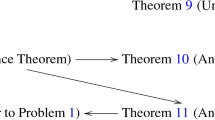Abstract
We consider, for each exchange matrix \(B\), a category of geometric cluster algebras over \(B\) and coefficient specializations between the cluster algebras. The category also depends on an underlying ring \(R\), usually \(\mathbb {Z},\,\mathbb {Q}\), or \(\mathbb {R}\). We broaden the definition of geometric cluster algebras slightly over the usual definition and adjust the definition of coefficient specializations accordingly. If the broader category admits a universal object, the universal object is called the cluster algebra over \(B\) with universal geometric coefficients, or the universal geometric cluster algebra over \(B\). Constructing universal geometric coefficients is equivalent to finding an \(R\)-basis for \(B\) (a “mutation-linear” analog of the usual linear-algebraic notion of a basis). Polyhedral geometry plays a key role, through the mutation fan \({\mathcal {F}}_B\), which we suspect to be an important object beyond its role in constructing universal geometric coefficients. We make the connection between \({\mathcal {F}}_B\) and \(\mathbf{g}\)-vectors. We construct universal geometric coefficients in rank \(2\) and in finite type and discuss the construction in affine type.





Similar content being viewed by others
References
Björner, A., Las Vergnas, M., Sturmfels, B., White, N., Ziegler, G.: Oriented Matroids. Encyclopedia of Mathematics and its Applications, vol. 46. Cambridge University Press, Cambridge, MA (1999)
Demonet, L.: Mutations of Group Species with Potentials and their Representations. Applications to Cluster Algebras, Preprint (2010). (arXiv:1003.5078)
Demonet, L.: Personal communication (2012)
Derksen, H., Weyman, J., Zelevinsky, A.: Quivers with potentials and their representations II: applications to cluster algebras. J. Am. Math. Soc. 23(3), 749–790 (2010)
Fock, V.V., Goncharov, A.B.: Cluster ensembles, quantization and the dilogarithm. Ann. Sci. Éc. Norm. Supér. (4) 42(6), 865–930 (2009)
Fock, V.V., Goncharov, A.B.: Cluster X-Varieties At Infinity. Preprint (2011). (arXiv:1104.0407)
Fomin, S., Shapiro, M., Thurston, D.: Cluster algebras and triangulated surfaces. I. Cluster complexes. Acta Math. 201(1), 83–146 (2008)
Fomin, S., Thurston, D.: Cluster Algebras and Triangulated Surfaces. Part II: Lambda Lengths. Preprint (2008)
Fomin, S., Zelevinsky, A.: \(Y\)-systems and generalized associahedra. Ann. Math. (2) 158(3), 977–1018 (2003)
Fomin, S., Zelevinsky, A.: Cluster algebras. I. Foundations. J. Am. Math. Soc. 15(2), 497–529 (2002)
Fomin, S., Zelevinsky, A.: Cluster algebras II: finite type classification. Invent. Math. 154, 63–121 (2003)
Fomin, S., Zelevinsky, A.: Cluster algebras IV: coefficients. Compos. Math. 143, 112–164 (2007)
Kac, V.: Infinite-Dimensional Lie Algebras, 3rd edn. Cambridge University Press, Cambridge, MA (1990)
Kelley, J.L.: General Topology. Graduate Texts in Mathematics, vol. 27. Springer, Berlin (1975)
Macdonald, I.G.: Affine root systems and Dedekind’s \(\eta \)-function. Invent. Math. 15, 91–143 (1972)
Nagao, K.: Donaldson–Thomas Theory and Cluster Algebras. Preprint (2010). (arXiv:1002.4884)
Nakanishi, T., Zelevinsky, A.: On tropical dualities in cluster algebras. In: Proceedings of Representation Theory of Algebraic groups and Quantum groups 10. Contemp. Math. vol. 565, pp. 217–226 (2012)
Plamondon, P.-G.: Cluster algebras via cluster categories with infinite-dimensional morphism spaces. Compos. Math. 147, 1921–1954 (2011)
Reading, N.: Cambrian lattices. Adv. Math. 205(2), 313–353 (2006)
Reading, N.: Clusters, Coxeter-sortable elements and noncrossing partitions. Trans. Am. Math. Soc. 359(12), 5931–5958 (2007)
Reading, N.: Universal Geometric Cluster Algebras from Surfaces. Preprint (2012). (arXiv:1209.4095)
Reading, N.: Universal Geometric Coefficients for the Once-Punctured Torus. Preprint (2012). (arXiv:1212.1351)
Reading, N., Speyer, D.E.: Cambrian fans. J. Eur. Math. Soc. (JEMS) 11(2), 407–447 (2009)
Reading, N., Speyer, D.: Sortable elements in infinite Coxeter groups. Trans. Am. Math. Soc. 363(2), 699–761 (2011)
Reading, N., Speyer, D.: Sortable elements for quivers with cycles. Electron. J. Comb. 17(1) (2010), Research Paper 90, p 19
Reading, N., Speyer, D.E.: Combinatorial Frameworks for Cluster Algebras. Preprint (2011). (arXiv:1111.2652)
Reading, N., Speyer, D.E.: Cambrian Frameworks for Cluster Algebras of Affine Cartan Type. In Preparation (2012)
Speyer, D.E.: Personal communication (2011)
Webster, R.: Oxford Science Publications. The Clarendon Press Oxford University Press, New York (1994)
Yang, S., Zelevinsky, A.: Cluster algebras of finite type via Coxeter elements and principal minors. Transform. Groups 13(3–4), 855–895 (2008)
Acknowledgments
Thanks to Ehud Hrushovski for enlightening the author on the subject of endomorphisms of the additive group \(\mathbb {R}\) (in connection with Remark 3.5). Thanks to David Speyer for pointing out the role of the polynomials \(P_m\) in describing the \(\mathbf{g}\)-vectors associated to rank-2 exchange matrices of infinite type. (See Sect. 9.) Thanks to an anonymous referee of [21] for pointing out that Proposition 4.6 needs the hypothesis that \(R\) is a field.Thanks to Kiyoshi Igusa and Dylan Rupel for helping to detect an error in an earlier version. Thanks to an anonymous referee of this paper for many helpful suggestions which improved the exposition.
Author information
Authors and Affiliations
Corresponding author
Additional information
This material is based upon work partially supported by the National Security Agency under Grant Number H98230-09-1-0056, by the Simons Foundation under Grant Number 209288 and by the National Science Foundation under Grant Number DMS-1101568.
Rights and permissions
About this article
Cite this article
Reading, N. Universal geometric cluster algebras. Math. Z. 277, 499–547 (2014). https://doi.org/10.1007/s00209-013-1264-4
Received:
Accepted:
Published:
Issue Date:
DOI: https://doi.org/10.1007/s00209-013-1264-4




